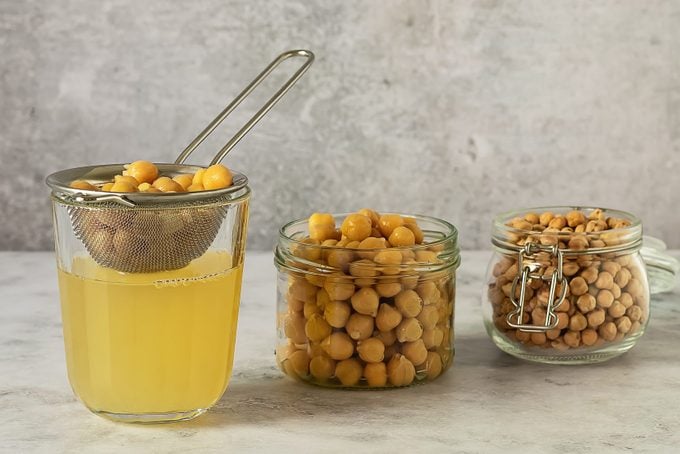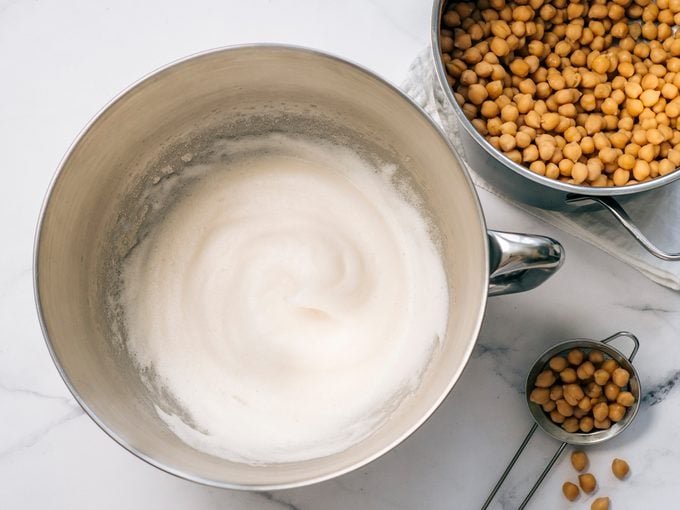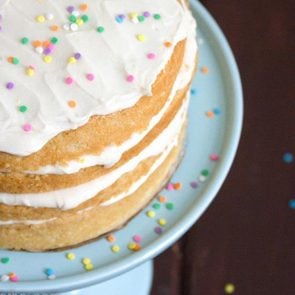Why Vegans Love Aquafaba and How to Make This Egg Substitute
Updated: Nov. 23, 2021
Aquafaba is an easy-to-make vegan egg substitute. Here's what to know about cooking with aquafaba. Plus, aquafaba recipes to try.
Aquafaba basics
The number of people choosing to following a vegan diet, a diet free from animal products or byproducts, has dramatically increased worldwide in the past 20 years. According to 2020 research from Ipsos Retail Performance, since 2004 the number of people who identify as vegan in the United States grew from around 290,000 people to a whopping 9.4 million people.
And the number of vegans globally is increasing for good reason. Research published in ISRN Nutrition found that consuming too much animal meat and protein is linked with an increased risk of kidney, liver, bone, and heart disease, and cancer.
Many people are also increasingly aware of the inhumane conditions many animals that end up on your table endure during their lives. Livestock also take a tremendous amount of natural resources to care for and process, and the animals themselves often emit high levels of gases that contribute substantially to climate change, such as methane and nitrous oxide, per Animal Frontiers.
According to experts, eggs can be one of the most difficult items to substitute in a vegan diet. That’s why nutritionists we spoke with advocate for the use of aquafaba, a product made from water left over after cooking beans or found in canned beans.
While bean water may not sound like the most appetizing food, experts say there are plenty of reasons to give aquafaba a shot.
Here’s what the experts want you to know about aquafaba.

What is aquafaba and where did it come from?
Aquafaba in Latin roughly translates to “bean water.” Aquafaba is the leftover water found in canned chickpeas and other pulses or the water leftover after boiling pulses.
For years, registered dietitians recommended that people toss out bean water and rinse canned beans before using them. But around 2015, an American vegan software engineer named Goose Wohlt discovered aquafaba while he was trying to make eggless meringues. Wohlt realized that if you whipped leftover bean water from chickpeas, also known as garbanzo beans, the resulting product mimics whipped egg whites. Some sources claim a French musician actually discovered aquafaba before Wohlt in 2014.
“In the past five to six years [aquafaba] has become quite popular, maybe because of the the influence of social media and popular chefs that have been promoting it,” says registered dietitian nutritionist Wesley McWhorter, DrPH, the director of culinary nutrition nourish program at the Michael & Susan Dell Center for Healthy Living UTHealth School of Public Health in Houston, Texas.
What is its taste, texture, and consistency of aquafaba?
Dr. McWhorter says it’s pretty easy to learn what the texture and consistency of aquafaba is by simply looking at the leftover water in canned beans or after boiling beans.
Aquafaba is a soupy liquid, unless it has been whipped into peaks, in which case it is the consistency and texture of whipped egg whites.
According to experts, aquafaba doesn’t normally have a strong bean taste, and you can’t notice it in many recipes. Dr. McWhorter says the taste of aquafaba usually becomes more subtle or is balanced out by other ingredients in savory or sweet dishes.
But depending on the type of pulse you use, aquafaba may have a slight hint of a taste akin to the taste of the pulse. Dr. McWhorter says beans like black-eyed peas or red kidney beans tend to have a stronger flavor, which is why many people make aquafaba from chickpea water, which has less of a bean taste.
Can aquafaba replace eggs in all contexts?
Aquafaba can be used to replace eggs in many recipes, but similar to other egg substitutes like flax eggs, they don’t really work as a replacement for things like scrambled, poached, or fried eggs.
“Aquafaba can replace the portion of egg in many food products such as egg-free mayonnaise, meringues, mousse, whipped cream, ice cream, emulsified dressings, cocktails, and bakery products,” says Yue He, a PhD candidate at the University of Saskatchewan in the department of chemical and biological engineering in Canada.
Aquafaba is so versatile because of its ratio of starch to protein, she adds, making it a great binder, emulsifier, and thickener like eggs. Unlike many other egg substitutes, aquafaba can also be whipped to form stiff or soft peaks.
Who can benefit from eating aquafaba?
Aquafaba can be used to replace animal products such as eggs, according to He. She says this makes aquafaba a great option for people with special dietary restrictions.
She adds that aquafaba may appeal to some people because it is also a cholesterol-free and eco-friendly additive for foods. Aquafaba is considered eco-friendly because it is plant-based and uses a product typically thrown away, reducing food waste.
Is aquafaba nutritious?
Aquafaba has nutritional value and potential health benefits, He notes. She says aquafaba dry matter mainly consists of polysaccharides, simple sugar, proteins, minerals, and minor phytochemical compounds called saponins and phenolic compounds, which can have health-promoting properties, such as reducing blood cholesterol level, blood lipid level, and improving blood glucose response.
Oligosaccharides also have antioxidant properties and can decrease the risk of some cancers. Some oligosaccharides, such as the compounds raffinose and stachyose, also function as prebiotics to stimulate the growth and survival of some beneficial intestinal bacteria.
Registered dietitian nutritionist Tricia L. Psota, PhD, the managing director of Nutrition on Demand, adds that aquafaba may also contain trace amounts of protein, B vitamins like folate and thiamin, and minerals like iron and phosphorus.
But all in all, there isn’t much nutrition in aquafaba. By some estimates each tablespoon of aquafaba contains around three to five calories and trace amounts of nutrients.
What do dietitians think about aquafaba?
According to the experts, aquafaba is a great food additive. Some have even referred to aquafaba as a “miracle ingredient.” Dietitians and nutritionists love aquafaba because it is so versatile and can make many dishes safe for people who cannot safely consume eggs or choose to not eat eggs for other reasons.
Chefs also love aquafaba because they can create dishes that do not need to be cooked, such as chocolate mousse, and do not need to worry about the potential for food-borne disease like you would with eggs. Aquafaba is also temperature-resistant, meaning you don’t have to worry as much about it burning or splitting.
Is there any reason not to eat aquafaba?
Despite all its perks, aquafaba does have one drawback: It can cause gas.
You may know beans can cause gas and flatulence if you’ve ever indulged in baked beans or bean-based dishes. That’s because beans and other pulses contain complex sugars called oligosaccharides that can be hard to digest. And a lot of the oligosaccharadies in pulses leach out into water when it is canned or boiled.
So people who are sensitive to beans or suffer from excess gas may want to stay away from aquafaba. But most recipes using aquafaba only call for small amounts of the ingredient. And consuming 3 tablespoons or less of aquafaba might not be enough to cause gas issues.
How you can make your own aquafaba at home?

Most of the experts say by far the easiest way to make aquafaba is to get it from a can of beans or other pulses.
“Saving the liquid from a can of chickpeas, preferably low- or no-salt-added options, is the most straightforward way to get aquafaba,” Dr. Psota says. “Before draining the can, shake it a few times so more starch is released from the beans into the liquid.”
Psota says aquafaba can also be made from scratch at home by soaking then cooking your own dried chickpeas.
“This method is less reliable because the cooking liquid needs to simmer down to the right consistency to match the canned liquid,” she adds. “It also is more time-consuming.”
Here is Psota’s recipe for homemade aquafaba:
Aquafaba recipe
Ingredients
1 pound of dried chickpeas
Water
Instructions
Soak 1 pound of dried chickpeas in water overnight, making sure to cover the beans with several inches of water, as they expand when soaking.
Drain the chickpeas, and add them to a large pot with 8 cups of unsalted water. Bring to a boil, reduce the heat, and simmer until the beans are tender (about 1.5 to 2 hours).
Once cooked, turn off the heat and cover with a lid, allowing the chickpeas to cool down in the cooking liquid. This leaves extra starch in the liquid, which is what gives aquafaba its egg-like properties.
When cool, remove the chickpeas with a slotted spoon, and then bring the cooking liquid to a simmer and cook for another 30 to 45 minutes. The liquid will reduce and become thicker, resembling the liquid that comes out of canned chickpeas—aquafaba.
Allow the aquafaba to cool, and store in the fridge for up to 5 days or freeze for months.
If you’re using aquafaba as a binder, such as in cookies or vegan mayonnaise, you can simply use aquafaba in its liquid form.
To make aquafaba into a foam you can use as a replacement for meringues and other similar ingredients, whip the reduced, cooled bean water for around 10 minutes with a small amount of vinegar, lemon juice, and cream of tartar. Experts say you’ll know the mixture is ready when it forms peaks like a whipped cream or whipped egg whites.
Do you need to buy special ingredients to make aquafaba?
Dr. McWhorter says it’s perfectly fine to use the dried or canned beans you already have in your cupboard or readily available at grocery stores to make aquafaba. “I do, however, recommend that people get sodium-reduced canned beans and other pulses because most regular products are very high in sodium,” he adds.
According to the experts, using leftover bean water from canned beans is typically easier than boiling beans for bean water because the water in canned beans has been soaking in the beans for a long time, meaning more of the desirable starches and proteins have leached out into the water.
In other words, canned bean water is already aquafaba. Using water that beans were boiled in takes longer to process into aquafaba because you have to reduce it for much longer.
McWhorter says the advantage of cooking beans at home to make aquafaba is that you can control the ingredients and salt level yourself.
(Here’s more on how to buy, make, and eat vegan bread.)
What type of beans or pulses make the best aquafaba?
Experts say almost any pulse, including many pulse-based products, can be used to make aquafaba. But most experts agree that white beans or chickpeas make the best aquafaba because their taste is so neutral.
“While the cooking liquid of other neutral-tasting beans can be used, chickpeas are the most common and versatile source of aquafaba,” Dr. Psota says.
Great recipes using aquafaba

When cooking or baking with aquafaba, it’s important to know that approximately 3 tablespoons is usually equivalent to about one whole egg, while 2 tablespoons is equivalent to around one egg white.
When it comes to favorite aquafaba recipes, He says her team has tried to replace egg with aquafaba in sponge cake, cookie, meringue, and mayonnaise in their kitchen lab. “My personal favorite is sponge cake,” she says.
Aquafaba sponge cake recipe
Ingredients
110 milliliters of aquafaba
1 teaspoon of apple cider vinegar
130 grams powdered sugar
130 g flour
7 g baking powder
Instructions
Whip 110 ml of aquafaba with 1 tsp (3 g) of apple vinegar to produce foam using a Kitchen Aid Ultra Power Mixer. Start on a low-speed setting until most of the aquafaba turns foamy and no liquid remains, then increase the speed to the maximum setting and whip for 7 minutes.
While mixing at the high-speed setting, add 130 g of powdered sugar. and whip the creamy mixture until a stiff peak is formed (3 minutes).
In a separate bowl, blend 130 g of flour and 7 g of baking powder, then gently fold into the foam using a rubber spatula.
Pour the cake batter into a baking pan (21 cm by 12 cm) and bake in a preheated conventional oven at 180°C (360°F) for 30 minutes.
After cooking, remove the pan from the oven and invert on a wire rack to cool at room temperature.
Other great aquafaba recipes
Here are some other aquafaba recipes experts and dietitians recommend:
Beet and apple salad in an edible walnut salad bowl
Serves 2
Ingredients
Edible Walnut Bowl
1 1/2 cups walnuts
1/4 cup ground flax seeds
6 pitted dates
2 tablespoons aquafaba
Pinch of salt
1/2 tsp coconut oil
Salad
3 cups spring mix greens
1 apple, diced
1 beet, diced or spiralized
1/4 cup dried cranberries
1/4 cup walnuts
1/2 cup balsamic vinaigrette
1 tsp whole flax seeds
Instructions
Preheat your oven to 400° F.
Add the walnuts, pitted dates, salt, and ground flax seeds in a food processor and pulse until the ingredients start to bind together with a fine consistency.
With the food processor still running, gradually pour the aquafaba into the mixture and pulse for another 60 seconds or so, then remove the mixture from the processor.
Split the mixture in half and put each half on an individual piece of parchment paper, then roll the halves into balls.
Coat a nonstick rolling pin with a bit of coconut oil and use the rolling pin to flatten the balls, making sure not to overwork the mixture.
Work from the inside out to gently flatten the mixture to around 1/4-inch thickness, making sure the crust doesn’t become too thin, but you will want it to have even thickness so it will cook evenly. You can smooth out cracks using your fingers.
Drape the parchment paper over a tiny, upside-down, oven-safe bowl and mold the mixture into a shape mimicking the shape of the bowl. Using your fingers, repair cracks and put the bowl on a cookie sheet. Cover the bowl-shaped crust with foil.
Bake for 30 minutes, then remove the foil and continue to bake it for an additional 3 minutes. Monitor the cooking progress to make sure the crust doesn’t get overly dark.
Remove bowl crust from the oven and let cool entirely while it is still molded over the bowl. Once the crust is fully cooled, carefully remove the piece of parchment paper and set the crust facing right-side up.
Fill the salad bowl with spring mix, beets, apples, beets, walnuts, and dried cranberries, then drizzle the salad with balsamic vinaigrette.
Vegan chocolate cherry mousse
Serves 4 to 6
Ingredients
3 cups frozen cherries, thawed
3/4 cup aquafaba (drained from one 15-ounce can)
1/4 tsp cream of tartar
1/3 cup confectioners sugar
1/3 cup almond milk
14 oz chopped chocolate (can use mix of dark and regular; use dairy-free for vegan)
Instructions
Put drained, thawed fruit into a medium saucepan and place it over medium heat. Cook the fruit, mashing and stirring the mixture frequently for 10 to 12 minutes until it reduces and becomes thick. The mixture is ready when there is enough liquid in the mixture to stop the mixture from sticking. If it does become too thick, you can add a tablespoon or two of a juice like cherry or orange juice. Take the mixture off the stove and set it aside to let it cool.
Place aquafaba, sugar, and cream of tartar in the bowl of a stand mixer. Beat the mixture at a medium-high speed for around 13 to 15 minutes until the liquid has tripled in volume and formed stiff peaks.
While the aquafaba mixture is whipping, slowly melt the chocolate and heat the almond milk inside a double boiler over medium-low heat. Stir the almond milk and chocolate until chocolate is completely melted and smooth. Instead of using a double boiler, you can also heat the almond milk and chocolate in a microwave-safe bowl, checking the mixture every 30 seconds to see if it has melted enough.
Put cooled chocolate into a large bowl and then fold in the aquafaba mixture delicately.
Divide half the fruit mixture in the bottom of four to six small bowls and dollop the chocolate aquafaba mousse on top of it. Place the bowls in the refrigerator for a minimum of one hour to let the desert set.
Right before serving, pour the remaining cherry mixture on top and, if desired, add shaved chocolate.
Aquafaba mayo
Ingredients
3 tbsp aquafaba liquid drained from a can of chickpeas
1 tbsp apple cider vinegar
1/2 tsp Dijon mustard
1/2 tsp salt
1 cup (236 ml) vegetable oil or any other kind of flavorless oil
1 tsp lemon juice
2 cloves garlic, minced
Instructions
Put aquafaba, mustard, salt, and vinegar into a a bowl and blend for a few seconds with an immersion blender or hand mixer until all ingredients are combined.
Keep the blender or mixer running and very gradually drizzle in the oil, ensuring it is fully combined as you pour it in. If the oil is added too fast the resulting mixture is too liquidy to use. If you are getting a bit of oil on the top of the mixture that will not combine, do not add any more oil and blend before continuing.
As you are blending the mixture, the mayonnaise will turn thick suddenly. Once all of the oil has been combined and thoroughly mixed, you can add the garlic and lemon juice and mix thoroughly.
Next, check out this other vegan egg substitute, flax egg.






















